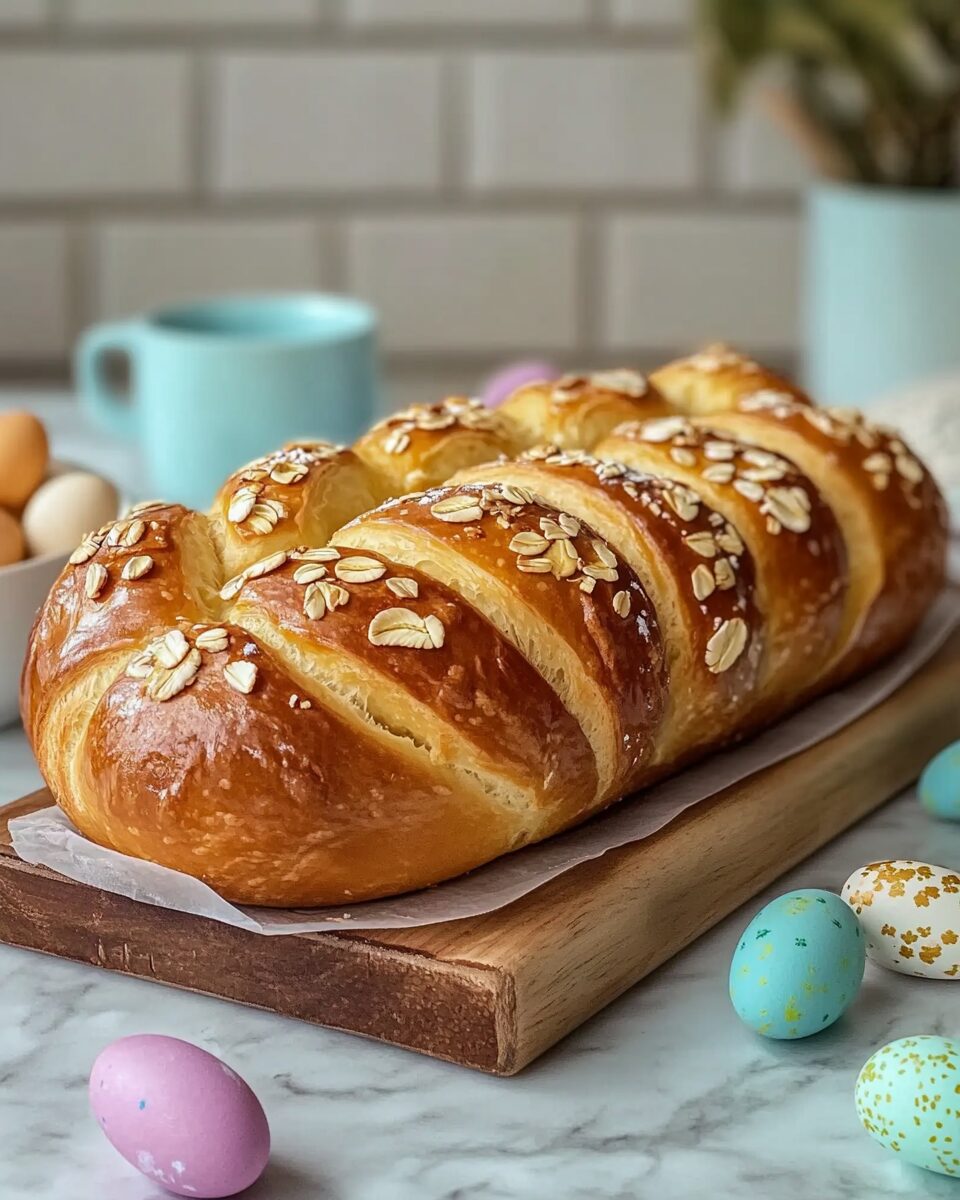This light and airy Easter Bread is just sweet enough to complement your traditional Easter dinner. It’s a braided bread topped with almonds and nonpareils for a festive touch. You can even make it the day before and use leftovers for delicious French toast the next morning!
Full Recipe:
Ingredients
- 1 (1/4-ounce) packet active dry yeast (2 1/4 teaspoons)
- 6 cups all-purpose flour, plus more for work surface and kneading
- 2/3 cup sugar
- 1 1/3 cups milk
- 6 tablespoons unsalted butter, plus more for greasing the bowl
- 1 teaspoon fine salt
- 2 large eggs, lightly beaten, plus 1 lightly beaten for egg wash
- 1/3 cup sliced skin-on almonds
- 1 tablespoon mini white nonpareils
Directions
- Pour 1/3 cup warm water (about 110°F) into the bowl of a stand mixer. Whisk in the yeast, 1 tablespoon of flour, and 1 tablespoon of sugar. Let sit until bubbly (5–10 minutes).
- In a small saucepan, heat the milk over medium heat until bubbles form around the edges (about 6 minutes). Remove from heat, and stir in the butter, remaining sugar, and salt. Let cool for about 10 minutes.
- Using a paddle attachment on medium-low speed, pour the milk mixture into the yeast mixture. Add 2 beaten eggs. Gradually mix in the remaining flour, beating until a soft dough forms. Increase speed to medium-high and beat until the dough pulls away from the sides (about 5 minutes).
- Transfer the dough to a lightly floured surface and knead for about 5 minutes until smooth and elastic. Place in a lightly buttered bowl, cover, and let rise in a warm place until doubled (about 1 1/2 hours).
- Line a baking sheet with parchment paper. Punch down the dough and divide it into 3 equal parts. Roll each piece into a 16-inch rope. Braid the ropes together, then tuck both ends under to form a long loaf. Cover and let rise until doubled (about 1 hour).
- Preheat oven to 350°F. Brush the loaf with the remaining beaten egg, then sprinkle almonds and nonpareils on top.
- Bake for 50–60 minutes, until golden brown and hollow-sounding when tapped. Let cool for 30 minutes before slicing.
Nutrients (Per Serving)
- Calories: ~290
- Carbohydrates: ~48g
- Protein: ~7g
- Fat: ~7g
- Saturated Fat: ~3g
- Cholesterol: ~40mg
- Sodium: ~160mg
- Fiber: ~2g
- Sugar: ~12g
Enjoy this traditional Easter treat with your loved ones! 🍞🌸
The History of Easter Bread
Easter Bread has deep roots in various cultures around the world. Many European countries have their versions of this holiday bread, with unique twists that reflect their traditions and customs. In Italy, it is known as “Pane di Pasqua” and is often adorned with colored eggs to symbolize new life. Greek Easter Bread, “Tsoureki,” is infused with orange zest and mahleb, a spice derived from cherry seeds. In Eastern Europe, “Paska” is a popular Easter bread made with rich ingredients, often decorated with religious symbols.
While each country has its unique version, the essence of Easter Bread remains the same—it is a celebration of renewal, hope, and togetherness.
What Makes This Easter Bread Special?
This particular Easter Bread is light, airy, and subtly sweet, making it the perfect complement to any Easter dinner. Unlike some richer variations, this recipe maintains a delicate balance of flavors that make it enjoyable on its own or as a base for other treats. The addition of sliced almonds and nonpareils not only enhances the flavor but also adds a festive touch.
One of the best things about this bread is its versatility. It can be enjoyed fresh out of the oven, lightly toasted with butter, or even transformed into French toast the next morning. The leftovers (if there are any) make for an excellent breakfast option!
The Role of Yeast in Easter Bread
Yeast is a crucial ingredient in this recipe, as it gives the bread its signature light and fluffy texture. Active dry yeast is used, which requires proofing in warm water before mixing with the other ingredients. This process ensures that the yeast is alive and ready to help the dough rise properly.
For the best results, it is essential to maintain the right temperature when working with yeast. The warm water should be around 110°F (43°C), as anything too hot can kill the yeast, while cooler temperatures may prevent it from activating. Allowing the dough to rise in a warm, draft-free environment ensures that it achieves the perfect texture.
The Art of Braiding the Dough
Braiding the dough is one of the most visually appealing aspects of this Easter Bread. The three-strand braid is the simplest and most common technique, but you can get creative with a four-strand or even a circular braided wreath.
To achieve an even braid, roll each dough rope to the same length and thickness before intertwining them. When braiding, avoid pulling too tightly, as this can restrict the dough’s ability to rise properly. Once braided, tucking the ends under creates a clean and polished appearance.
Enhancing the Flavor and Texture
While the base recipe is already delightful, there are several ways to enhance the flavor and texture of your Easter Bread.
- Citrus Zest: Adding a teaspoon of lemon or orange zest can give the bread a refreshing aroma and subtle tangy flavor.
- Vanilla or Almond Extract: A dash of vanilla or almond extract can deepen the bread’s flavor profile.
- Dried Fruits: Raisins, dried cranberries, or chopped apricots can be kneaded into the dough for added sweetness and texture.
- Spices: A pinch of cinnamon or nutmeg can add warmth and depth to the flavor.
Decorating Your Easter Bread
The final touches make this Easter Bread truly special. The egg wash before baking gives the bread a beautiful golden brown color and a slight sheen. The sliced almonds provide a crunchy contrast to the soft texture of the bread, while the nonpareils add a playful and festive touch.
For an extra festive look, you can insert dyed eggs into the braid before baking. These eggs cook gently in the oven, adding both beauty and tradition to the bread. If you choose to do this, be sure to use raw, dyed eggs instead of hard-boiled ones, as they will cook during the baking process.
Storage and Serving Suggestions
Easter Bread is best enjoyed fresh, but it can also be stored for later enjoyment. To keep it soft and fresh, store it in an airtight container or wrap it tightly in plastic wrap at room temperature for up to three days. If you want to extend its shelf life, you can freeze the bread by wrapping it securely in plastic wrap and placing it in a freezer bag. When ready to eat, simply thaw it at room temperature and warm it slightly in the oven.
This bread is delicious on its own, but it pairs wonderfully with a variety of accompaniments. Spread with butter, jam, or honey for a simple yet satisfying treat. For a more indulgent option, use it as the base for French toast, allowing the slightly sweet bread to soak up the flavors of cinnamon, vanilla, and eggs.
Conclusion
Easter Bread is more than just a delicious treat—it is a symbol of tradition, togetherness, and celebration. Whether you are continuing a long-standing family tradition or starting a new one, baking this bread is a wonderful way to embrace the spirit of Easter.
With its light and airy texture, subtle sweetness, and festive decorations, this bread is sure to be a highlight of your Easter gathering. Plus, its versatility means you can enjoy it in multiple ways, from fresh slices at dinner to a delightful breakfast the next morning.
So, gather your ingredients, embrace the art of baking, and share the joy of Easter Bread with your loved ones!






